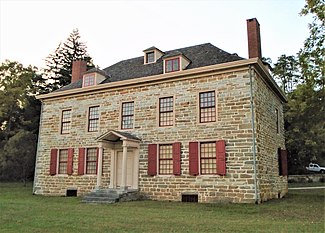Fort Johnson | |
 (2020) | |
| Location | 2 Mergner Rd., Fort Johnson, NY |
|---|---|
| Nearest city | Amsterdam |
| Coordinates | 42°57′26″N74°14′30″W / 42.95722°N 74.24167°W |
| Area | 1 acre (0.40 ha) |
| Built | ca. 1749 |
| Architectural style | Georgian |
| NRHP reference No. | 72000858 |
| Significant dates | |
| Added to NRHP | November 28, 1972 [1] |
| Designated NHL | November 28, 1972 [2] |
Old Fort Johnson is a historic house museum and historic site at 2 Mergner Road (junction of New York State Routes 5 and 67) in Fort Johnson, New York. It is the site of Fort Johnson, a two-story stone house originally enclosed in fortifications built by Sir William Johnson about 1749. The fort served as Johnson's home, business office and trading center until 1763 when he moved to Johnson Hall in what is now Johnstown, New York. [3] Sir William's son Sir John Johnson owned the house from 1763 until 1776, when it was confiscated by the local Committee of Safety. The house remains and is owned and operated as a museum by the Montgomery County Historical Society. It was designated a National Historic Landmark in 1972. [2] [4] [5]

